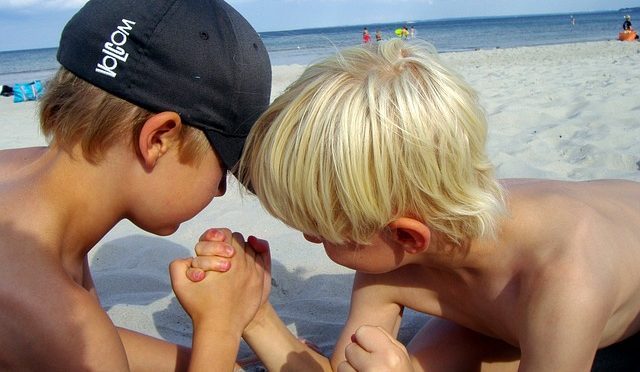This is an excerpt from Helping Mothers be Closer to Their Sons: Understanding the World of Boys. The book is good for dad’s too!
The sexes are different in their strategies to get what they want. This difference starts early. Boys tend to be more physical and direct, demanding or playfully pushing another boy in order to obtain what he wants. Girls don’t seem to like this sort of method. Girls are more likely to use words or relational means to get what they want. Boys tend not to respond to this. Neither sex seems to be too keen on the other’s modes.
To get a better idea of how boys and girls differ in this way, lets look briefly at the anthropological research of Ritch Savin Williams observing an adolescent summer camp.17 Groups of boys and girls aged eleven to fourteen were housed in their own cabins. Let’s look at the boys’ cabins first.
Very soon after arrival, the boys started challenging each other, sometimes telling each other what to do, sometimes putting the other boys down. Each of these were maneuvers to try to attain higher dominance in the hierarchy of boys. Pushing and shoving was not unusual nor was making fun of weakness. In fact if weakness was exposed, the other boys would sometimes join in to mark their own dominance. Some boys barked orders and others followed, while some put up a challenge. The boys’ pecking order, their hierarchy, was being made clear to all and it happened fairly quickly.
Savin Williams found that both boys and girls used ridicule and name-calling as a means to create higher dominance. But there were some strategies used by the girls that were very different. Unlike the boys, Savin Williams says that the girls maintained a sweet and agreeable attitude for the first week, making friends and being nice. But after the first week was up the girls started their own ploys to gain dominance. Their modes were more relational and less direct. Girls would ignore someone, or appear to “not hear” another girl in order to maintain dominance. Other tactics included gossip, social alienation, misinformation and withholding eye contact.
The boys’ strategy seems to be overt and out in the open. They seem to lack concern for the feeling reactions of their friends and are more likely to throw their weight around with bravado in order to be higher on the hierarchy. They just don’t seem to care as much if someone gets hurt in the process. The important thing is to be on top. We can see this sort of thing when boys are together with their friends and they will openly put each other down. Moms get upset with this but it needs to be understood as being their way to navigate the hierarchy. This does not mean that we shouldn’t help boys find kindness towards their friends; it does however mean that we need to understand these behaviors in their context.
The girls’ strategy seems more passive and clandestine. Savant Williams tells us that the girls, unlike the boys, seem to want to be perceived as “nice” and maintain that image whenever possible thus they take a week to build alliances prior to starting to use dominance tactics. Their dominance strategies are designed to be stealthy. Their strategies are often easily denied as not being “on purpose” or by claiming they had no motive to hurt. All the while the hurtful behaviors flow via social alienation, gossip, exclusion and other means.
Both boys’ and girls’ strategies leave some chaos in their aftermath, the boys’ more overt and the girls’ more covert. Both strategies are designed to create and maintain dominance over their peers. It is easy to see how these very different strategies don’t mix very well. This may play into what we will look at next, the very different ways that boys and girls choose to play.
Pg 22-24 Helping Mothers be Closer to their Sons: Understanding the World of Boys
If you are interested in learning more about relationships from a Red Pill Perspective you might want to check out Paul and Tom’s Patreon site on Red Pill Relationships
Tom Golden is the author or three books, Swallowed by a Snake: The Gift of the Masculine Side of Healing, The Way Men Heal, and Helping Mothers be Closer to Their Sons: UnderStanding the Unique World of Boys. Tom was the creator of the youtube channel Men Are Good , was in the Red Pill Movie, and served as the vice chairman of the Maryland Commission for Men’s Health. He has been a therapist in private practice for over 30 years.
